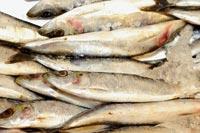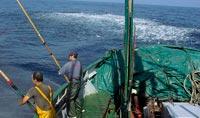Aquaculture, the fishing of the future?

Something must be done. In the world there are about 6 billion inhabitants, a figure that is increasing. At the same time, fish consumption is increasing. And what to do to face this problem? Can you promote fish farms? Or in other words, to boost aquaculture? This work includes professors Imanol Garate and Inazio Manterola at the aquaculture school in Mutriku, in the port of Mutriku. There a higher grade training cycle on aquaculture production has been launched. Among them, the organization of aquaculture production processes, the cultivation of clams, prawns and sea bream. Mutriku is the first aquaculture school in the Basque Country.
And what is aquaculture? To say the same thing, the teachers of the school of aquaculture have given us a series of definitions: a field that encompasses the breeding techniques of every aquatic being, the controlled growth of every aquatic being... In short, aquaculture encompasses the breeding techniques of beings, plants or animals, both freshwater and saltwater.
Different criteria can be used when classifying different types of aquaculture. For example, if the medium or medium of cultivation is used as a criterion, it can be distinguished between marine aquaculture and continental aquaculture. However, these classifications are merely descriptive. The classification incorporating functional approaches is much more useful.
Depending on the degree of control the crops receive, two types of growth are usually distinguished: extensive and intensive. However, the separation between the two is not often clear.
These crops are logically related to the objectives of aquaculture. In general, two main objectives can be distinguished: to guarantee the survival of the population and to obtain an economic benefit.
The first type of cultivation is generally carried out in developing countries, especially in Southeast Asia. Its geographical characteristics are very suitable due to the abundance of rivers, lakes and marshes. The products obtained there are essential to feed the population. In industrialized countries, however, the goal is to obtain an economic benefit.
In the words of Imanol, “in Euskal Herria, aquaculture is not yet included in the Neolithic. Aquaculture is not seen as a future. But this is largely due to the lack of agents and wills. Two arguments have always been used here to justify the infeasibility of aquaculture: one with very abrupt sea and one with a very expensive coastal square meter, so the construction of any facility is very expensive.”
From the point of view of aquaculture, sea bream would be a species that could grow on the Cantabrian coast. And the sea bream is a very appreciated fish and very little. In addition, it has a good price in the market. Therefore, bream is very likely to reproduce in nurseries and produce benefits.
Production oriented aquaculture
Nowadays, it can be said that aquaculture is mainly oriented to production. Many young specimens must be produced and then fattened to a suitable size in the market. The production of juveniles is carried out in special facilities called hatchery. Adults prepare for laying, incubate eggs and grow larvae in juvenile nurseries. The cultivation of the postlarvae is carried out in facilities called nursery, from where they are transferred to the fattening facilities.
Normally there are companies that take care of taking the larvae forward and others that seek to fatten them.

For the cultivation of larvae live organisms are used as food. Most fish are carnivorous, and in most cases the larvae are given Brachionus or Artemia crustacean. The rotifers, so to speak, are very small fish from the sea and are given before they begin to give Artemia. But to fatten they are given the feed. The right feed should be chosen: the need for food should be satisfactory and, at the same time, it should not be expensive, since growth would not be profitable.
Very few companies work comprehensively. They need several techniques. In the fattening plant, for example, no phytoplankton or zooplankton is needed; packaging and water are needed to grow these beings and feed. And another technique to feed, give light and care for the quality of water. A Hatchery uses thinner technology
With all these techniques, for example, in the case of lubines, survival from viable eggs until juveniles eat the feed is 10-15%. This fact, however, is not small. In fact, about a hundred thousand eggs are laid per kilo of female, so ten thousand eggs advance. Not bad, isn't it? This is impossible in a natural ecosystem or in the open sea. Somehow, aquaculture bets on the number of eggs. The strategy is to produce millions of eggs, so that, despite some dying, many will survive, always more than in the open sea.
The application of aquaculture techniques allows each generation to leave a lot of huge beings, which, apart from production, opens the possibility of repopulation seas and rivers.
But there is also danger. Genetic biodiversity is huge at sea. Consequently, the dumping of thousands of specimens of a species cultivated in aquaculture significantly impoverishes this genetic diversity. Not only that, various diseases or malformations can also happen to the wild population.
Play with the head
To act seriously in aquaculture it is essential to know data of the wild population, such as genetic properties, diseases, density, etc. And before you start, concrete programs will be needed. “Aquaculture is, in short, a set of techniques that the human being clearly puts ethics,” Imanol stresses. Measure the environmental impact of each technique. “One thing is the hole a mole can make on the ground and another what a drill can do. Both have effects on the environment, but differently.”

Something similar happens in aquaculture. It is impossible to rely solely on productivity. For example, in aquaculture dirty waters are formed, food remains remain in the sea and antibiotics are used in the breeding process. Measure the environmental impact of all of them. Antibiotics, for example, are dangerous biological agents used for water treatment and, in many cases, mixed with food. However, the current trend is ecological aquaculture, as in agriculture.
Referring to human intervention, we cannot forget what happened last spring in the anchovy campaign. In this sense, Ignacio told us that 15-20 years ago the growth of anchovy was proposed in nurseries, or at least prepare people to make anchovy, know the life cycle, etc.
In the words of Ignatius, “at that time he was ignored. And now the anchovy has disappeared. Few expected. Perhaps if this had not been done at that time, the current problem of anchovy would have been much less.” Maybe. However, it does not seem that we get to exhaust all the fish from the open sea and consume only the fish from the farms.
History of AquacultureThe issue of aquaculture is very old. BC. In 2000 several fish were grown in the ponds of China. A few years later the first book on fish growth was written. This book made special mention of the tent. However, the technology of the time cannot be compared to the current one, it was very simple. Fish were possessed in ponds, so they could be taken as needed. Also the Romans cultivated some species (eel, oyster). In the Middle Ages, fish grew on the sides of the monasteries. Full lifecycle control of the tent, for example, was obtained in the Middle Ages. Soon after the trout was obtained, with which the growth of marine fish has progressively developed. The cultivation of molluscs has a long history, but it is in the last 50 years when it has developed most, especially in Japan, the United States, France and Galicia. The breeding of mussels began as a result of the accident of a ship, the XIII. In the 20th century. Since then, mussels began to be produced in tablates located in the intertidal area. The first nursery was installed in Galicia, in Villagarcia, Arosa, and currently Galicia is the largest European producer of mussels. Growth of lobster in the 19th century. It began in the twentieth century and was the main promoter of the works carried out by the researcher Fujinaga. In fact, adults managed to put out the natural environment and the growth of the larvae. The procedures then used were widely extended in later years. |
Other aquaculture productions

The only marine products are not fish, and aquaculture does not exclude algae, mussels and seafood. Although the animals that grow the most in the world are fish, the cultivation of molluscs is the most widespread in Europe. In European cuisine algae are not frequently used and most of the algae collected are used in the pharmaceutical and food industry, but in Asia the situation is very different and the cultivation of algae will be a future activity. Currently in Asia approximately 2.5 million tons of algae are produced.
Although not usual, there is another production: that of the pearl oyster. It occurs in the Persian Gulf and in the northern Pacific islands for the enjoyment of the rich.





